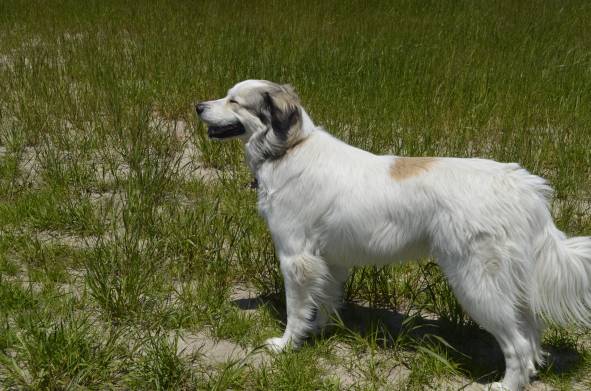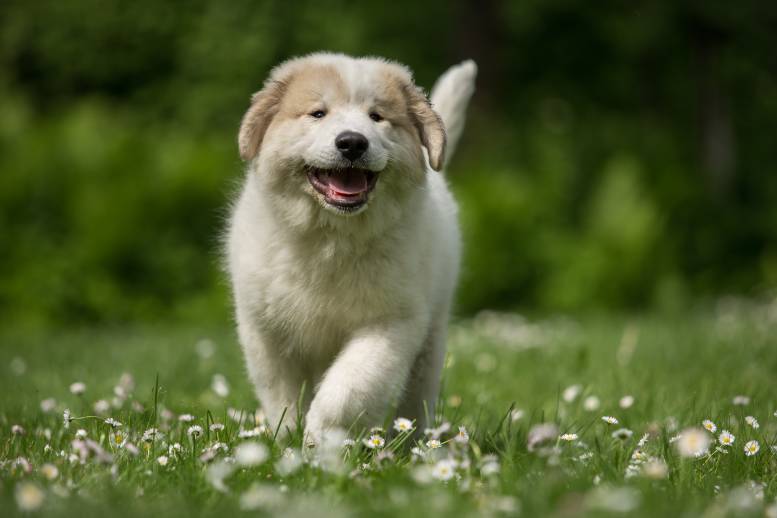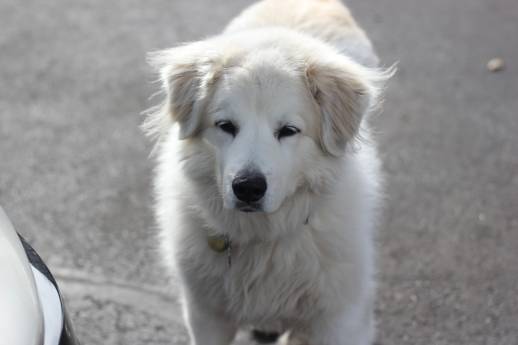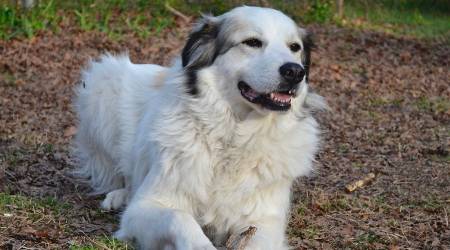Connect with a verified veterinarian in minutes. Licensed vets are available 24/7 to answer your questions. No need to worry about your furry family member.
Are you thinking about adopting an Anatolian Shepherd Great Pyrenees Mix? Are you familiar with this cross-bred dog? If so, then you’ve come to the right place! It’s always best to know about the dog breed before making the commitment to adopt one of these beautiful dogs.
We’ve put together some information to help you learn more about these amazing dogs! So you’ll have more information on whether this is the right dog for you and your family.
What is an Anatolian Shepherd Great Pyrenees Mix?
The Anatolian Shepherd Great Pyrenees Mix is a hybrid mix between two different dog breeds, the Anatolian Shepherd and the Great Pyrenees dog (or Pyr). Both of these parent breeds are working dogs most often used for herding cattle and as livestock guardian dogs.
Let’s take a look at each of the parents of these beautiful mixed breed dogs.
The Anatolian Shepherd
The Anatolian Shepherd is a dog that originally came from Anatolia (Turkey), where they were bred to be herding dogs. The history of these dogs goes back about 6,000 years. These are very large dogs with an independent spirit, one of the traits that makes them excellent herding dogs.
The dogs were bred to be large and strong to protect their herd and shepherds. Another interesting fact is that once the puppies were grown, they were no longer fed! The dogs were expected to hunt their own food, which included gophers and other small animals. They never attacked their herd. What’s more, the dogs usually wore iron collars with long spikes. The collars worked to protect the dogs from other animals intent on harming the herd.
This dog breed didn’t make it to the US until just before WWII. They were brought to the country as part of a secret project to find the best working dog to be used on American farms. However, this project died when the war started. However, by the 1950s they were again being imported by American farmers.
It wasn’t until 1970 that the first litter was born in the US. They were born to Lieutenant Robert Ballard, who brought two Anatolian Shepherds home from Turkey. The breed was ultimately recognized by the AKC in 1996.
Anatolian Shepherds have a lot of energy and are highly intelligent. However, these dogs can be challenging to train with their independent spirit. It’s said the dogs act on instinct, and for this reason, they are not used for protection or guard dogs. The training necessary for this work can make the dogs more aggressive.
These are loyal dogs with very protective natures. They will protect their family and property quite well. The dogs are wary of strangers.
Anatolian Shepherd dogs require plenty of obedience training and socialization from a young age. With the right training and pet parent, these dogs can make wonderful family pets.
Anatolian Shepherds usually come in a variety of colors, including fawn, white, pinto, or brindle. They tend to have black masks on their faces. Anatolian Shepherds tend to have a short coat combined with a thick undercoat. They sometimes have feathering behind their ears, legs, and on their tail.
When it comes to grooming, the Anatolian Shepherd should be brushed about once a week. They only need a bath about 3-4 times a year, or when they’re very dirty and smelly. That’s good news since these are very large dogs!
When it comes to size, Anatolian Shepherds can stand between 27 to 29 inches tall and weigh between 80 to 150 lbs. These are massive dogs! Their size and independence mean these dogs may also try to become dominant. For this reason, they aren’t the best dogs for first-time pet parents.
These are generally healthy dogs, but they can suffer from some health issues. Common health problems asssociated to this breed include:
- Hip & elbow dysplasia
- Demodectic mange
- Hypothyroidism
- Entropion
Are these dogs good with kids? Generally speaking, Anatolian Shepherds are good with children. They tend to be very calm and protective. However, they’re very large and may accidentally hurt a young child. So, it’s best to always supervise the dogs around kids. And children need to be taught how to correctly treat and approach the dog.

Review symptoms, medications & behavior to keep your pets healthy with a Vet Online in just minutes.
Ask a Vet Live NowGreat Pyrenees
Great Pyrenees were also originally bred to be herding dogs. However, today, they’re also used as search & rescue dogs, therapy dogs, and more.
Their ancestry dates back to about 3000 BC when the dogs were used to herd cattle in the Pyrenees Mountains. In the Middle Ages, these dogs were usually owned by peasants. However, by 1675, the Dauphin of King Louis XIV made the dog breed the Royal Dog of France! The aristocracy then began to buy these dogs and use them to guard their estates.
The first Great Pyrenees brought to North America were imported to Newfoundland, Canada. From there, the breed spread out across the continent.
Another interesting fact about these dogs is that they have extremely sensitive hearing! They can hear the sounds of intruders even when the TV and air conditioner are going! Because they hear so well, the dogs have a tendency to bark a lot and very loudly. This is part of the dog’s breeding since the ability to warn off predators and intruders was necessary when herding cattle.
Great Pyrenees are considered giant dogs. They stand between 25 to 32 inches and weigh between 85 to 160 lbs. That’s pretty big!
When it comes to personality, the dogs are usually calm and gentle. They are also highly courageous and loyal to his family. It’s these qualities that make them wonderful therapy dogs. They love nothing more than to provide warmth and comfort to their families and others.
These are intelligent dogs that are used to working on their own. This means they are highly intelligent and independent, making the dogs somewhat challenging to train. It’s imperative to make sure a Great Pyrenees receives training and socialization from a young age.
Great Pyrenees are usually healthy dogs; however, they can develop the following health issues:
- Gastric torsion (also referred to as bloat)
- Hip & elbow dysplasia
- Patellar luxation
- Addison’s disease
- Cataracts
- Entropion
- Anesthesia sensitivity
When it comes to grooming, these dogs do shed quite a bit. However, they only require about 30 minutes a week of brushing. The dogs have a double coat, which protects them in all types of weather. The top coat is long, thick, and coarse, while the undercoat is dense and wooly.
Great Pyrenees are usually white with white markings; however, they can also have badger, tan, gray, or reddish/brown markings. These usually appear on the dog’s ears and tail but can sometimes appear on the body.
Many people are surprised that these large dogs can manage to live quite well in an apartment! That’s because the Great Pyrenees is laid back and easy-going. However, they still need plenty of exercise to wear off some of their energy.
Are these dogs good with kids? Great Pyrenees love children! These dogs will protect kids with their lives. They’re also very gentle and loving with kids. These dogs also get along well with other dogs and pets in the home. When they are off-leash, they are very protective of their territory.
You might have heard of some other good family dogs such as the German Shepherd, Border Collie, Golden Retriever, and Labrador. The similarity between these dogs is that they all have a calm, friendly demeanor, with a love for people and a strong desire to please. Because they are often bred as herding dogs, these good dogs can make great companions.
What About the Anatolian Shepherd Great Pyrenees Mix?
As you can see, the parents of the Anatolian Shepherd Great Pyrenees Mix are wonderful dogs! They’re a mix of purebred dogs, who are highly intelligent, affectionate, loyal, and love to work. However, what other characteristics does the Anatolian Pyrenees get from their parents?
The Anatolian Great Pyrenees Mix tends be a large dog. They can stand between 27-29 inches and weigh between 80-150 lbs. They have an average lifespan of 11-13 years. What’s more, these hybrid puppies don’t stop growing until they’re between 13 to 14 months old!
What’s more, Anatolian Great Pyrenees can be stubborn, which makes them somewhat challenging to train. The dogs are not the right choice for first-time pet parents. The dogs should be trained from a young age, and they require proper socialization to be well-rounded, happy dogs. Keep in mind these dogs should not be trained to be watchdogs. This training could make the dogs more aggressive.
Anatolian Pyrenees Exercise Needs
Anatolian Pyrenees are very active dogs. They require plenty of exercise each day, which can include walking and playing. These dogs love to play fetch! An Anatolian Pyrenees Mix requires at least 45 to 60 minutes of exercise each day. And the exercise needs to be pretty strenuous. Remember, these dogs come from parents who are strong working dogs!
When out walking, these dogs need to be kept on a leash rather than allowed to run free. This is because they can become aggressive with other dogs and humans when protecting their family and pet parent.
Having a backyard is best for these dogs; however, they can be great escape artists! For this reason, dog owners should have at least a 6 ft fence (or higher) on their yards.
Another interesting fact is that some of these dogs enjoy swimming!
These dogs love to go for walks; however, they also benefit from having access to a large yard. They love to run and play, which allows them to release all that pent-up energy! If these hybrid dogs don’t get enough exercise, they can become irritable and destructive.
In addition, the Anatolian Pyrenees is a breed that can suffer from separation anxiety. You must take your dog for daily walks and never leave him or her alone for long periods of time. This breed will thrive on daily interactions with you and your family. This is especially true if you have other dogs in the home.
Grooming
Anatolian Pyrenees sheds heavily twice a year. You will find hair everywhere in your home, especially if you have other dogs in the home. You may also find some hair on your clothes and furniture. So, be sure to brush your dog regularly during this time of year.
When it comes to grooming, your Anatolian Pyrenees Mix will need to be brushed at least once a week or more. Your fur baby may need a bath about once a month, which is great news since these are very large dogs! Wrangling one into the tub could be a challenge!
Keep in mind these dogs do shed a lot. And we do mean a lot. These are not the best dogs for people who have allergies or who can’t deal with white fur on everything. These shedders are very large and can be hard to house train. They’re not the best dogs for people who don’t have a lot of time to devote to grooming.
Some tips for dealing with the shedding:
- Get a crate for your dog. This will keep your dog in one place, helping to minimize hair around the house.
- Get some doggie combs and brush your dog regularly.
- Check for ticks after the spring and fall months. This is a very common problem with Anatolian Pyrenees Mixes. The spring and fall are when ticks are most active.
- Keep your house very clean. Don’t let your dog jump on the furniture or up on the counter.
- Clean your dog’s ears regularly.
- Have your dog’s nails trimmed regularly.
Anatolian Pyrenees Diet
What does an Anatolian Pyrenees eat? They need at least three cups of food a day. The dog food should be a high-quality food, formulated for large, active-breed dogs.
Meals should be given about 2-3 times a day, depending on your dog’s age, health, and activity level.
Health
As a giant dog breed, Anatolian Pyrenees can develop certain health conditions, including:
Hip & elbow dysplasia
- Demodectic mange
- Patella luxation
- Entropion
- Bloat
- Hypothyroidism
- Pavo
- Ear infections
- Cancer
- Anesthesia sensitivity
Training
Anatolian Pyrenees Mix is highly intelligent and independent. For these reasons, they require training and socialization from a young age. Dogs who are not trained well may become aggressive and begin resource guarding. They’re also able to chew up almost anything in the home.
So, these dogs need to start training when they’re puppies. The training should be consistent and positive, including reward treats for good behavior.
How Much Does an Anatolian Pyrenees Mix Cost?
The cost of adopting an Anatolian Pyrenees Mix varies depending on several factors. For instance, adopting a puppy from a reputable breeder costs more than getting the puppy from a rescue or a puppy mill breeder.
When adopting from a reputable breeder, an Anatolian Pyrenees Mix can cost between $300 and $1000 and more.
If you choose to adopt from a rescue, the adoption fees will vary. However, on average, you may pay between $100 to $300 to adopt from a rescue or shelter.
Keep in mind that puppies adopted in urban areas are usually more expensive than those adopted in smaller towns or rural areas.
Summing It Up
There’s no question that the Anatolian Pyrenees hybrid mix is a beautiful, amazing dog! They are lovely companions when they receive the proper training and socialization from a young age. The dogs are best for pet parents who understand the needs of this dog breed and know how to properly train large, independent dogs.
These dogs can make wonderful family companions with the right training and socialization. They’re famous for being loving, gentle, and protective. The dogs get along with kids and other pets in the home; however, they should never be left unsupervised with young kids.
Is this the right dog for you? Yes, if you can meet the needs of these intelligent, sweet, gentle giant dogs!
Connect with a verified veterinarian in minutes. Licensed vets are available 24/7 to answer your questions. No need to worry about your furry family member.

Julie
Julie is a graduate of the University of North Carolina, Wilmington, where she studied Animal science. Though contrary to the opinion of her parents she was meant to study pharmacy, but she was in love with animals especially cats. Julie currently works in an animal research institute (NGO) in California and loves spending quality time with her little cat. She has the passion for making research about animals, how they survive, their way of life among others and publishes it. Julie is also happily married with two kids.
Review symptoms, medications & behavior to keep your pets healthy with a Vet Online in just minutes.
Ask a Vet Live Now




